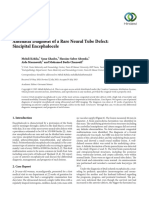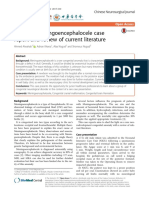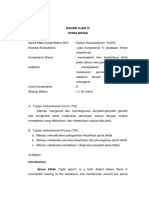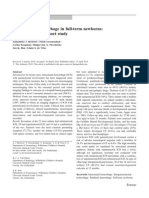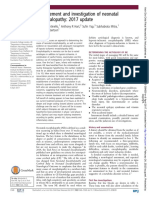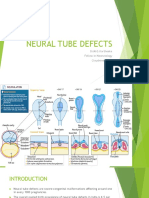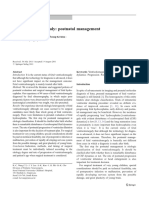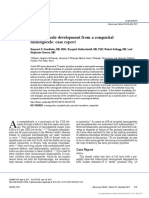Professional Documents
Culture Documents
Encephalocele Prenatal Diagnosis About A Case
Original Title
Copyright
Available Formats
Share this document
Did you find this document useful?
Is this content inappropriate?
Report this DocumentCopyright:
Available Formats
Encephalocele Prenatal Diagnosis About A Case
Copyright:
Available Formats
Volume 6, Issue 4, April – 2021 International Journal of Innovative Science and Research Technology
ISSN No:-2456-2165
Encephalocele Prenatal Diagnosis: About a Case
Meimouna Mohamed Lemine, Ezza Lemrabot, Karam Mouhammed Saoud,
Nessrine Mamouni, Senae Errarhay ; Chahrazad Bouchikhi ; Abdelaziz Banani
Department of Obstetric and Gynecology I .Uhc Hassan II of Fes, Marocco
Sidi Mohamed Ben Abdellah University, Faculty of Medicine and Pharmacy of Fes.
Corresponding Author : Meimouna Mohamed Lemine
Abstract:- Encephalocele is the consequence of an Case 1:
incomplete closure of the cranial cavity. The prognosis Patient aged 45 years, large multiparous, without
depends on the topography and volume of the lesion. The notable pathological history, admitted in labor on a
antenatal diagnosis is made during the first trimester pregnancy estimated at 38SA + 5 days, the pregnancy was
ultrasound in 80% of cases. We report two cases of followed at the health center, without notion of
encephalocele diagnosed antenatally by ultrasound in morphological ultrasound. An ultrasound scan was
our department and managed immediately at birth by performed, showing a severe hydrocephalus (figure 1), with
pediatric surgeons and neonatologists. a bi-parietal diameter of 118mm, with a brain parenchyma
of 9mm, associated with a parietal encephalocele (figure 2),
I. INTRODUCTION hence the indication for a caesarean delivery. Extraction of a
male neonate, Abgard 10/10, birth weight 3300g, with
Encephalocele is defined as the exteriorization of brain presence of a macrocrania and an intact parietal
tissue and/or meninges outside the skull cavity through a encephalocele of 14cm (figure 3), neonate with good
congenital bony defect. The detection rate of cephaloceles in adaptation to the extrauterine life, neurological examination
the first trimester has been estimated at 80% and it does not reveal any other abnormality, entrusted to the
constitutes 5% of all severe structural abnormalities of the pediatric surgeon for an eventual cure of encephalocele.
central nervous system (CNS)[1].
Figure 1, 2 : ultrasound images of a mass in the parietal bone, heterogeneous and predominantly anechogenic, evoking an
encephalocele, and a severe hydrocephalus
Figure 3 : aspect of the parietal encephalocele after delivery
IJISRT21APR435 www.ijisrt.com 869
Volume 6, Issue 4, April – 2021 International Journal of Innovative Science and Research Technology
ISSN No:-2456-2165
Case 2: occipital encephalocele (figure 4) making 3cm, without
Patient aged 27 years, with no notable pathological other associated signs, notably no hydrocephalus or other
history; second action; without notion of consanguinity, neural tube closure anomalies, vaginal delivery was
current pregnancy not followed (contracted in the period of accepted, expulsion of a male newborn; the clinical
pandemic Covid 19), admitted in active phase of labor on a examination confirmed the presence of an occipital
pregnancy which is said to be at term, an obstetrical encephalocele (figure 5) with a scalloped sac; with a normal
ultrasound was made before entering the delivery room and neurological examination and good adaptation to extra
which objectified an evolutive mono-fetal pregnancy with uterine life. He was subsequently referred to the pediatric
presence of an anechne occipital mass in favor of an surgery department for management.
4 5
Figure 4 : a heterogeneous occipital mass, with an anechogenic component, suggesting an occipital encephalocele.
Figure 5 : aspect of the occipital encephalocele after delivery.
II. DISCUSSION encephaloceles, with diagnosis usually made in the second
trimester. [5]
Encephalocele affects 0.8 to 5 in 10,000 live births, [2]
with marked geographic and ethnic variations. While the Although the onset of cephaloceles apparently occurs
prevalence of neural tube defects has decreased significantly between 25 and 50 days of gestation (for lesions located
since the folic acid fortification that was recommended in anteriorly) and up to 60 days (for posterior defects), but the
the early 1990s, this question has been controversial with median GA of diagnosis is approximately 18 weeks of
respect to the development of cephaloceles [3, 4]. gestation according to the literature [8].
For both patients folic acid supplementation was not for our two patients the diagnosis was late because
taken nor were other supplements taken during their they were not followed up; their pregnancies occurred at the
pregnancy. same time as the pandemic period of COVID 19
with prognosis dependent on the amount of herniated The etiology of cranial hernias is not fully understood,
brain tissue and other associated malformations. [5] More but includes ethnic, genetic, and environmental factors. It is
than 75% of encephalocele cases are occipital in location, simply a failure of separation of the neural ectoderm from
while others may be frontal or parietal. [7] Prenatal the surface ectoderm after closure of the rostral neuropore
diagnosis is usually made by ultrasound (US). during the four weeks of gestation. [9].
Schoner K, et all reported on a study done on neural Weichert J and all [10] have reported, 80% of defects
tube defects; they found 17.7% of meningo-encephaloceles are occipital versus 6% parietal. It is interesting to note that
represent. [6] for our reported cases one is occipital of small the latter are discussed as not constituting a genuine form of
size and was not associated with other malformation; and in neural tube defect, but rather an origin of the defect
the other case the encephalocele is of parietal localization stemming rather from environmental influences (e.g.,
which is a rare form of the encephalocele, and is associated reduced folic acid consumption) ; and It has recently been
with severe hydrocephalus and in any case the diagnosis is established that maternal passive smoking is an independent
made by ultrasound. risk factor for three subtypes of NTDs (anencephaly, spina
bifida and more strongly encephalocele) [11, 12].
Prenatal ultrasound to assess fetal morphology is
usually performed early in pregnancy, between 11 and 14 In terms of management, a neurosurgical opinion is
weeks' gestation, and can detect a wide range of congenital warranted. In a previous study published by Kiymaz et al,
anomalies, including neural tube defects. [7] Two- [13] factors such as lesion size, amount of neural tissue
dimensional ultrasound can detect approximately 80% of contained, ventriculomegaly, and other accompanying
abnormalities negatively affected the prognosis of these
IJISRT21APR435 www.ijisrt.com 870
Volume 6, Issue 4, April – 2021 International Journal of Innovative Science and Research Technology
ISSN No:-2456-2165
patients. The amount of neural tissue involved is associated [11]. Wang M, Wang ZP, Zhang M, Zhao ZT (2014)
with the severity of subsequent neurodevelopmental delays. Maternal passive smoking during pregnancy and
It has also been reported that only about 17% of patients neural tube defects in offspring: a meta-analysis. Arch
with encephaloceles had normal development, whereas 83% Gynecol Obstet 289:513–521
of patients had severe psychomotor developmental [12]. Suarez L, Ramadhani T, Felkner M, Canfield M,
delays[14] Although the treatment is surgical correction, Hendricks K (2011) Maternal smoking, passive
encephalocele remains a disorder with very high morbidity tobacco smoke, and neural tube defects. Birth Defects
and mortality rates despite appropriate treatment. Res A Clin Mol Teratol 91:29–33
[13]. Kiymaz N, Yilmaz N, Demir I, Keskin S. Prognostic
III. CONCLUSION factors in patients with occipital encephalocele. Pediatr
Neurosurg 2010; 46:6–11
Encephalocele can appear isolated or as part of a [14]. French BN. Midline fusion defects and defects of
polymalformative pattern. The antenatal diagnosis is mainly formation. In: Youmans JR (ed). Neurological
based on ultrasound. Advice to parents must be tailored Surgery. Philadelphia, PA: WB Saunders Co;
individually and on a case-by-case basis; in a 1990:1164–1169.
multidisciplinary approach with neuropediatricians,
geneticists and neurosurgeons.
REFERENCES
[1]. Cameron M, Moran P (2009) Prenatal screening and
diagnosis of neural tube defects. Prenat Diagn 29:402–
411
[2]. Siffel C, Wong LY, Olney RS, Correa A. Survival of
infants diagnosed with encephalocele in Atlanta,
1979–98. Paediatr Perinat Epidemiol 2003; 17:40–48
[3]. Rowland CA, Correa A, Cragan JD, Alverson CJ
(2006) Are encephaloceles neural tube defects?
Pediatrics 118:916–923
[4]. Thompson DN (2009) Postnatal management and
outcome for neural tube defects including spina bifida
and encephalocoeles. Prenat Diagn 29:412–419
[5]. Liao S, Tsai PY, Chen YC, Chang CH, Ko HC, Chang
FM. Prenatal diagnosis of fetal encephalocele using
three-dimensional ultrasound. J Med Ultrasound 2012;
20:150–154
[6]. Schoner K, Axt-Fliedner R, Bald R, Fritz B, Kohlhase
J, Kohl T, Rehder H. Fetal Pathology of Neural Tube
Defects - An Overview of 68 Cases. Geburtshilfe
Frauenheilkd. 2017 May;77(5):495-507. doi:
10.1055/s-0043-103459. Epub 2017 May 24. PMID:
28579621; PMCID: PMC5444532.
[7]. Fong KW, Toi A, Salem S, et al. Detection of fetal
structural abnormalities with US during early
pregnancy. Radiographics 2004; 24:157–174
[8]. Bannister CM, Russell SA, Rimmer S, Thorne JA,
Hellings S (2000) Can prognostic indicators be
identified in a fetus with an encephalocele? Eur J
Pediatr Surg 10(Suppl 1):20–23
[9]. ten Donkelaar HJ, Bekker M, Renier WO, Hori A,
Shiota K (2014) Neurulation and neural tube defects.
In: ten Donkelaar HJ (ed) Clinical neuroembryology,
2nd edn. Springer, Heidelberg, pp 165–217
[10]. Weichert J, Hoellen F, Krapp M, Germer U, Axt-
Fliedner R, Kempe A, Geipel A, Berg C, Gembruch U.
Fetal cephaloceles: prenatal diagnosis and course of
pregnancy in 65 consecutive cases. Arch Gynecol
Obstet. 2017 Sep;296(3):455-463. doi:
10.1007/s00404-017-4424-7. Epub 2017 Jun 20.
PMID: 28634753.
IJISRT21APR435 www.ijisrt.com 871
You might also like
- JurnalDocument5 pagesJurnalAnonymous 65zjdAVNo ratings yet
- Alwahab2017 Article OccipitalMeningoencephaloceleC PDFDocument4 pagesAlwahab2017 Article OccipitalMeningoencephaloceleC PDFOvamelia JulioNo ratings yet
- Fetal Neurology - Volume IDocument1 pageFetal Neurology - Volume IMina zhouNo ratings yet
- Ajns 13 233Document5 pagesAjns 13 233Ade Cahyo IslamiNo ratings yet
- New Born Children With Encephalocele: Imedpub JournalsDocument4 pagesNew Born Children With Encephalocele: Imedpub Journalsglory haurissaNo ratings yet
- ResumenDocument5 pagesResumenPaulette BuñayNo ratings yet
- Early Life Serum Neurofilament Dynamics Predict Neurodevelopmental Outcome of Preterm InfantsDocument8 pagesEarly Life Serum Neurofilament Dynamics Predict Neurodevelopmental Outcome of Preterm InfantsKatharina GoeralNo ratings yet
- Retrospective Examination of Infants With Congenital Neural Tube DefectDocument8 pagesRetrospective Examination of Infants With Congenital Neural Tube Defectözkan ilhanNo ratings yet
- 1 PBDocument7 pages1 PBsahrirNo ratings yet
- No. 44. Neural Tube DefectsDocument11 pagesNo. 44. Neural Tube DefectsenriqueNo ratings yet
- FTPDocument2 pagesFTPDesta FransiscaNo ratings yet
- Spinal DisDocument32 pagesSpinal DisAkmal Niam FirdausiNo ratings yet
- A Multiparity Woman With Pregnancy of Recurrent Anencephaly A Rare Case ReportDocument2 pagesA Multiparity Woman With Pregnancy of Recurrent Anencephaly A Rare Case ReportInternational Journal of Innovative Science and Research TechnologyNo ratings yet
- CP Neon EncepthDocument9 pagesCP Neon EncepthJuan Carlos HuanacheaNo ratings yet
- Cranial Ultrasound Findings in Late Preterm Infants and Correlation With Perinatal Risk FactorsDocument7 pagesCranial Ultrasound Findings in Late Preterm Infants and Correlation With Perinatal Risk FactorsM Ibnu Rahman SyahNo ratings yet
- Intracranial Calcifications in Childhood - Part 1Document24 pagesIntracranial Calcifications in Childhood - Part 1Amanda Povoa de PaivaNo ratings yet
- Neonatal Encephalopathy: Need For Recognition of Multiple Etiologies For Optimal ManagementDocument7 pagesNeonatal Encephalopathy: Need For Recognition of Multiple Etiologies For Optimal ManagementDiana De La CruzNo ratings yet
- Neural Tube Defects: Group 1Document28 pagesNeural Tube Defects: Group 1imneverwrong2492100% (1)
- Cornell A 2003Document13 pagesCornell A 2003dnazaryNo ratings yet
- Clinico-Etiological Pattern of Neonatal Seizures: Pediatric Department, Faculty of Medicine, Al-Azhar UniversityDocument16 pagesClinico-Etiological Pattern of Neonatal Seizures: Pediatric Department, Faculty of Medicine, Al-Azhar UniversityMahmoud AbouelsoudNo ratings yet
- Pattern of Encephaloceles A Case SeriesDocument4 pagesPattern of Encephaloceles A Case SeriesSayyid Hakam PerkasaNo ratings yet
- Avances en Convulsiones NeonatalesDocument10 pagesAvances en Convulsiones NeonatalesMarysol UlloaNo ratings yet
- Seminars in Fetal & Neonatal Medicine: Chakrapani Vasudevan, Malcolm LeveneDocument7 pagesSeminars in Fetal & Neonatal Medicine: Chakrapani Vasudevan, Malcolm LeveneAngelica AponteNo ratings yet
- Fetal Neurology - Volume IIDocument1 pageFetal Neurology - Volume IIMina zhouNo ratings yet
- AnencephalyDocument6 pagesAnencephalyMetta SariNo ratings yet
- The Role of Transcranial Ultrasound in The Evaluation of Hypoxic Ischemic EncephalopathyDocument8 pagesThe Role of Transcranial Ultrasound in The Evaluation of Hypoxic Ischemic EncephalopathyIJAR JOURNALNo ratings yet
- Maller2019 Neonatal Head Ultrasound Part 2Document12 pagesMaller2019 Neonatal Head Ultrasound Part 2Modou NianeNo ratings yet
- Obstetric neurological injuries explainedDocument8 pagesObstetric neurological injuries explainedaish25No ratings yet
- 10.1007@s00381 020 04746 9Document12 pages10.1007@s00381 020 04746 9Alvaro Perez HenriquezNo ratings yet
- Espina Bifida 2022Document7 pagesEspina Bifida 2022Edwin Fabian Paz UrbanoNo ratings yet
- Management Outcomes of Hydrocephalus Among Under Five Children in A Tertiary Hospital in Gombe North Eastern NigeriaDocument4 pagesManagement Outcomes of Hydrocephalus Among Under Five Children in A Tertiary Hospital in Gombe North Eastern NigeriaInternational Journal of Innovative Science and Research TechnologyNo ratings yet
- DiscursoDocument21 pagesDiscursoLeslye SimbañaNo ratings yet
- Devries2009 Evolving Understanding ofDocument10 pagesDevries2009 Evolving Understanding ofModou NianeNo ratings yet
- Bahan Ajar Iv Spina BifidaDocument7 pagesBahan Ajar Iv Spina Bifidaanon_800290919No ratings yet
- Congenital Hydrocephalus Prevalence Prenatal DiagnosisDocument6 pagesCongenital Hydrocephalus Prevalence Prenatal DiagnosisnendaayuwandariNo ratings yet
- Intracranial Hemorrhage in Full-Term Newborns: A Hospital-Based Cohort StudyDocument10 pagesIntracranial Hemorrhage in Full-Term Newborns: A Hospital-Based Cohort StudyTriponiaNo ratings yet
- Mcgovern 2020Document9 pagesMcgovern 2020AmatystNo ratings yet
- Encefalopatia Neonatal PDFDocument13 pagesEncefalopatia Neonatal PDFVanessa RomeroNo ratings yet
- AsfixiaDocument3 pagesAsfixiaClaudia LópezNo ratings yet
- Atretic Cephaloceles May Indicate Underlying Brain AbnormalitiesDocument6 pagesAtretic Cephaloceles May Indicate Underlying Brain AbnormalitiesAhmed H. Ali ElbestaweyNo ratings yet
- MeningomyeloceleDocument34 pagesMeningomyelocelerajan kumarNo ratings yet
- Neural Tube Defects: Dr.M.G.Kartheeka Fellow in Neonatology Cloudnine, OARDocument36 pagesNeural Tube Defects: Dr.M.G.Kartheeka Fellow in Neonatology Cloudnine, OARM G KARTHEEKANo ratings yet
- Clinical Features, Diagnosis, and Treatment of Neonatal EncephalopathyDocument15 pagesClinical Features, Diagnosis, and Treatment of Neonatal EncephalopathyAlvaro SagredoNo ratings yet
- Epidemiology of Brachial Plexus Palsy in NewbornsDocument7 pagesEpidemiology of Brachial Plexus Palsy in NewbornsMardyana MardinNo ratings yet
- Shunt Exposure As A Ventriculoperitoneal Shunt Complication A CaseDocument8 pagesShunt Exposure As A Ventriculoperitoneal Shunt Complication A CasePutri Tamara DasantosNo ratings yet
- Crisis en Eega de Vrie 2019Document38 pagesCrisis en Eega de Vrie 2019Jimmy Pino CoricazaNo ratings yet
- Manejo Post Reanimacion AsfixiaDocument6 pagesManejo Post Reanimacion AsfixialauracamilacaceresdNo ratings yet
- Thoracic-Omphalopagus Conjoined Twins A Case Report and Review of The LiteratureDocument3 pagesThoracic-Omphalopagus Conjoined Twins A Case Report and Review of The LiteratureInternational Journal of Innovative Science and Research TechnologyNo ratings yet
- Liu 2016Document2 pagesLiu 2016Anonymous l3X3jf0NPNo ratings yet
- Fetal Ventriculomegaly: Postnatal Management: Special Annual IssueDocument3 pagesFetal Ventriculomegaly: Postnatal Management: Special Annual IssueRendra Artha Ida BagusNo ratings yet
- (19330715 - Journal of Neurosurgery - Pediatrics) Encephalocele Development From A Congenital Meningocele - Case ReportDocument4 pages(19330715 - Journal of Neurosurgery - Pediatrics) Encephalocele Development From A Congenital Meningocele - Case ReportalaineaNo ratings yet
- Basic NewerDocument9 pagesBasic Newerblack smithNo ratings yet
- Antenatal Diagnosis ofDocument6 pagesAntenatal Diagnosis ofnskhldNo ratings yet
- Encephalocele 2Document4 pagesEncephalocele 2lisdiana putriNo ratings yet
- Davis 2003Document9 pagesDavis 2003Apotik ApotekNo ratings yet
- Articol 1Document7 pagesArticol 1nistor97No ratings yet
- Seminars in Pediatric Surgery: Progress in Anesthesia and Management of The Newborn Surgical PatientDocument5 pagesSeminars in Pediatric Surgery: Progress in Anesthesia and Management of The Newborn Surgical PatientAsif KhanNo ratings yet
- Epileptic Encephalopathies SYNGAP1Document7 pagesEpileptic Encephalopathies SYNGAP1Saya OtonashiNo ratings yet
- Neonatal Seizures: Current Management and Future ChallengesFrom EverandNeonatal Seizures: Current Management and Future ChallengesLakshmi NagarajanRating: 4 out of 5 stars4/5 (2)
- Surgical Treatment of Epilepsies: Diagnosis, Surgical Strategies, ResultsFrom EverandSurgical Treatment of Epilepsies: Diagnosis, Surgical Strategies, ResultsNo ratings yet
- Automatic Power Factor ControllerDocument4 pagesAutomatic Power Factor ControllerInternational Journal of Innovative Science and Research TechnologyNo ratings yet
- Intelligent Engines: Revolutionizing Manufacturing and Supply Chains with AIDocument14 pagesIntelligent Engines: Revolutionizing Manufacturing and Supply Chains with AIInternational Journal of Innovative Science and Research TechnologyNo ratings yet
- Navigating Digitalization: AHP Insights for SMEs' Strategic TransformationDocument11 pagesNavigating Digitalization: AHP Insights for SMEs' Strategic TransformationInternational Journal of Innovative Science and Research TechnologyNo ratings yet
- A Review: Pink Eye Outbreak in IndiaDocument3 pagesA Review: Pink Eye Outbreak in IndiaInternational Journal of Innovative Science and Research TechnologyNo ratings yet
- Teachers' Perceptions about Distributed Leadership Practices in South Asia: A Case Study on Academic Activities in Government Colleges of BangladeshDocument7 pagesTeachers' Perceptions about Distributed Leadership Practices in South Asia: A Case Study on Academic Activities in Government Colleges of BangladeshInternational Journal of Innovative Science and Research TechnologyNo ratings yet
- Securing Document Exchange with Blockchain Technology: A New Paradigm for Information SharingDocument4 pagesSecuring Document Exchange with Blockchain Technology: A New Paradigm for Information SharingInternational Journal of Innovative Science and Research TechnologyNo ratings yet
- Mobile Distractions among Adolescents: Impact on Learning in the Aftermath of COVID-19 in IndiaDocument2 pagesMobile Distractions among Adolescents: Impact on Learning in the Aftermath of COVID-19 in IndiaInternational Journal of Innovative Science and Research TechnologyNo ratings yet
- Studying the Situation and Proposing Some Basic Solutions to Improve Psychological Harmony Between Managerial Staff and Students of Medical Universities in Hanoi AreaDocument5 pagesStudying the Situation and Proposing Some Basic Solutions to Improve Psychological Harmony Between Managerial Staff and Students of Medical Universities in Hanoi AreaInternational Journal of Innovative Science and Research TechnologyNo ratings yet
- Review of Biomechanics in Footwear Design and Development: An Exploration of Key Concepts and InnovationsDocument5 pagesReview of Biomechanics in Footwear Design and Development: An Exploration of Key Concepts and InnovationsInternational Journal of Innovative Science and Research TechnologyNo ratings yet
- Perceived Impact of Active Pedagogy in Medical Students' Learning at the Faculty of Medicine and Pharmacy of CasablancaDocument5 pagesPerceived Impact of Active Pedagogy in Medical Students' Learning at the Faculty of Medicine and Pharmacy of CasablancaInternational Journal of Innovative Science and Research TechnologyNo ratings yet
- Formation of New Technology in Automated Highway System in Peripheral HighwayDocument6 pagesFormation of New Technology in Automated Highway System in Peripheral HighwayInternational Journal of Innovative Science and Research TechnologyNo ratings yet
- Natural Peel-Off Mask Formulation and EvaluationDocument6 pagesNatural Peel-Off Mask Formulation and EvaluationInternational Journal of Innovative Science and Research TechnologyNo ratings yet
- Drug Dosage Control System Using Reinforcement LearningDocument8 pagesDrug Dosage Control System Using Reinforcement LearningInternational Journal of Innovative Science and Research TechnologyNo ratings yet
- The Effect of Time Variables as Predictors of Senior Secondary School Students' Mathematical Performance Department of Mathematics Education Freetown PolytechnicDocument7 pagesThe Effect of Time Variables as Predictors of Senior Secondary School Students' Mathematical Performance Department of Mathematics Education Freetown PolytechnicInternational Journal of Innovative Science and Research TechnologyNo ratings yet
- Enhancing the Strength of Concrete by Using Human Hairs as a FiberDocument3 pagesEnhancing the Strength of Concrete by Using Human Hairs as a FiberInternational Journal of Innovative Science and Research TechnologyNo ratings yet
- Supply Chain 5.0: A Comprehensive Literature Review on Implications, Applications and ChallengesDocument11 pagesSupply Chain 5.0: A Comprehensive Literature Review on Implications, Applications and ChallengesInternational Journal of Innovative Science and Research TechnologyNo ratings yet
- Advancing Opthalmic Diagnostics: U-Net for Retinal Blood Vessel SegmentationDocument8 pagesAdvancing Opthalmic Diagnostics: U-Net for Retinal Blood Vessel SegmentationInternational Journal of Innovative Science and Research TechnologyNo ratings yet
- The Making of Self-Disposing Contactless Motion-Activated Trash Bin Using Ultrasonic SensorsDocument7 pagesThe Making of Self-Disposing Contactless Motion-Activated Trash Bin Using Ultrasonic SensorsInternational Journal of Innovative Science and Research TechnologyNo ratings yet
- Placement Application for Department of Commerce with Computer Applications (Navigator)Document7 pagesPlacement Application for Department of Commerce with Computer Applications (Navigator)International Journal of Innovative Science and Research TechnologyNo ratings yet
- REDLINE– An Application on Blood ManagementDocument5 pagesREDLINE– An Application on Blood ManagementInternational Journal of Innovative Science and Research TechnologyNo ratings yet
- Beyond Shelters: A Gendered Approach to Disaster Preparedness and Resilience in Urban CentersDocument6 pagesBeyond Shelters: A Gendered Approach to Disaster Preparedness and Resilience in Urban CentersInternational Journal of Innovative Science and Research TechnologyNo ratings yet
- Exploring the Clinical Characteristics, Chromosomal Analysis, and Emotional and Social Considerations in Parents of Children with Down SyndromeDocument8 pagesExploring the Clinical Characteristics, Chromosomal Analysis, and Emotional and Social Considerations in Parents of Children with Down SyndromeInternational Journal of Innovative Science and Research TechnologyNo ratings yet
- Handling Disruptive Behaviors of Students in San Jose National High SchoolDocument5 pagesHandling Disruptive Behaviors of Students in San Jose National High SchoolInternational Journal of Innovative Science and Research TechnologyNo ratings yet
- Safety, Analgesic, and Anti-Inflammatory Effects of Aqueous and Methanolic Leaf Extracts of Hypericum revolutum subsp. kenienseDocument11 pagesSafety, Analgesic, and Anti-Inflammatory Effects of Aqueous and Methanolic Leaf Extracts of Hypericum revolutum subsp. kenienseInternational Journal of Innovative Science and Research TechnologyNo ratings yet
- A Curious Case of QuadriplegiaDocument4 pagesA Curious Case of QuadriplegiaInternational Journal of Innovative Science and Research TechnologyNo ratings yet
- A Knowledg Graph Model for e-GovernmentDocument5 pagesA Knowledg Graph Model for e-GovernmentInternational Journal of Innovative Science and Research TechnologyNo ratings yet
- Analysis of Financial Ratios that Relate to Market Value of Listed Companies that have Announced the Results of their Sustainable Stock Assessment, SET ESG Ratings 2023Document10 pagesAnalysis of Financial Ratios that Relate to Market Value of Listed Companies that have Announced the Results of their Sustainable Stock Assessment, SET ESG Ratings 2023International Journal of Innovative Science and Research TechnologyNo ratings yet
- Pdf to Voice by Using Deep LearningDocument5 pagesPdf to Voice by Using Deep LearningInternational Journal of Innovative Science and Research TechnologyNo ratings yet
- Adoption of International Public Sector Accounting Standards and Quality of Financial Reporting in National Government Agricultural Sector Entities, KenyaDocument12 pagesAdoption of International Public Sector Accounting Standards and Quality of Financial Reporting in National Government Agricultural Sector Entities, KenyaInternational Journal of Innovative Science and Research TechnologyNo ratings yet
- Fruit of the Pomegranate (Punica granatum) Plant: Nutrients, Phytochemical Composition and Antioxidant Activity of Fresh and Dried FruitsDocument6 pagesFruit of the Pomegranate (Punica granatum) Plant: Nutrients, Phytochemical Composition and Antioxidant Activity of Fresh and Dried FruitsInternational Journal of Innovative Science and Research TechnologyNo ratings yet
- Applying Value Engineering to Improve Quality and Reduce Costs of Ready-Mixed ConcreteDocument15 pagesApplying Value Engineering to Improve Quality and Reduce Costs of Ready-Mixed ConcreteayyishNo ratings yet
- Electrical Machines Multiple Choice Questions - Mcqs - QuizDocument10 pagesElectrical Machines Multiple Choice Questions - Mcqs - Quiztooba mukhtarNo ratings yet
- Termites and Microbial Biological Control StrategiesDocument30 pagesTermites and Microbial Biological Control StrategiesMuhammad QasimNo ratings yet
- Solid Waste ManagementDocument26 pagesSolid Waste ManagementPamela MendozaNo ratings yet
- OE Spec MTU16V4000DS2250 3B FC 50Hz 1 18Document6 pagesOE Spec MTU16V4000DS2250 3B FC 50Hz 1 18Rizki Heru HermawanNo ratings yet
- Chapter 4 Cost MinimizationDocument6 pagesChapter 4 Cost MinimizationXavier Hetsel Ortega BarraganNo ratings yet
- Lab Manual Cape Bio Unit 1 2023Document37 pagesLab Manual Cape Bio Unit 1 2023drug123addict25No ratings yet
- Nitocote WP DDocument4 pagesNitocote WP DdaragNo ratings yet
- Patient Positioning: Complete Guide For Nurses: Marjo S. Malabanan, R.N.,M.NDocument43 pagesPatient Positioning: Complete Guide For Nurses: Marjo S. Malabanan, R.N.,M.NMercy Anne EcatNo ratings yet
- Kuffner Final PresentationDocument16 pagesKuffner Final PresentationSamaa GamalNo ratings yet
- Nakshatra Exaltation DebilitationDocument3 pagesNakshatra Exaltation DebilitationBhanu Pinnamaneni100% (1)
- Chapter-8 Turbine and Governor TestingDocument10 pagesChapter-8 Turbine and Governor Testingafru2000No ratings yet
- Ch3 XII SolutionsDocument12 pagesCh3 XII SolutionsSaish NaikNo ratings yet
- GPS and The Quest For Pizza: National Aeronautics and Space AdministrationDocument1 pageGPS and The Quest For Pizza: National Aeronautics and Space Administrationvijay maddiNo ratings yet
- Rincon Dueling RigbyDocument5 pagesRincon Dueling Rigbytootalldean100% (1)
- Poultry DiseasesDocument5 pagesPoultry DiseasesAnjum IslamNo ratings yet
- Palm Wine SpecificationDocument10 pagesPalm Wine SpecificationUday ChaudhariNo ratings yet
- Advanced Radiographic Techniques PDFDocument21 pagesAdvanced Radiographic Techniques PDFelokfaiqNo ratings yet
- r05320202 Microprocessors and Micro ControllersDocument7 pagesr05320202 Microprocessors and Micro ControllersSri LalithaNo ratings yet
- Synopsis - AVR Based Realtime Online Scada With Smart Electrical Grid Automation Using Ethernet 2016Document19 pagesSynopsis - AVR Based Realtime Online Scada With Smart Electrical Grid Automation Using Ethernet 2016AmAnDeepSinghNo ratings yet
- Desiderata: by Max EhrmannDocument6 pagesDesiderata: by Max EhrmannTanay AshwathNo ratings yet
- 2.gantry Rotation Safety CheckDocument2 pages2.gantry Rotation Safety CheckLê Hồ Nguyên ĐăngNo ratings yet
- Dimensional Analysis Similarity Lesson2 Dimensional Parameters HandoutDocument11 pagesDimensional Analysis Similarity Lesson2 Dimensional Parameters HandoutRizqi RamadhanNo ratings yet
- Radar PPNDocument5 pagesRadar PPNSawaf MfNo ratings yet
- UntitledDocument340 pagesUntitledFelipe Batista RetkeNo ratings yet
- Cosmic Freedom: David MolineauxDocument2 pagesCosmic Freedom: David Molineauxsalomon46No ratings yet
- LOD Spec 2016 Part I 2016-10-19 PDFDocument207 pagesLOD Spec 2016 Part I 2016-10-19 PDFzakariazulkifli92No ratings yet
- Meningitis & EncephalitisDocument7 pagesMeningitis & EncephalitisABAKADANo ratings yet
- Finals-Insurance Week 5Document19 pagesFinals-Insurance Week 5Ryan ChristianNo ratings yet
- Presentation 123Document13 pagesPresentation 123Harishitha ManivannanNo ratings yet
